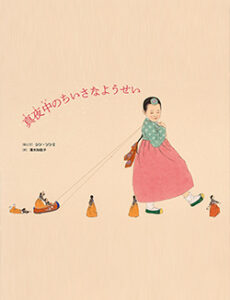2021 Participants
Hasegawa Keita
Past Program / 2021 Program / Hasegawa Keita
■ Hasegawa Keita asks Seo Chaelyn, editor of 〈Ant faireies in the Midnight〉(Changbi Publishers)


Q. Hasegawa Keita
What do you consider to be “timeless and universal” in creating children’s books?
A. Seo Chaelyn
In the book 〈Ant fairies in the Midnight〉, the characters are dressed in hanbok though, the story contains something that anyone, regardless of nationality, can empathize with. The feelings such as love for children, childhood memories, and longing for the time that cannot be returned, can be fully conveyed to Japanese readers too, I believe. The other way round, books made in Japan much earlier are so beloved by Korean children of today. For example, the story of more than 30 years ago in Japan, whose protagonist rides a train, eats bento, and lives on a tatami mat, is still enjoyed by Korean children in the 2020s. It is because the theme in the book is still meaningful. We are working hard to find, create, and introduce stories that do not lose their lights even if time passes and goes beyond space.
These days, a lot of new style children’s picture books are being introduced. After all, a book being remembered for a long time is determined by how much it satisfies the hopes or desires that children have in common, I think. Again, improving power of a story or a message seems to be the basic thing to do to ensure universality that transcends time.
Q. Hasegawa Keita
As the environment, scientific progress, social situations and political situations change drastically day by day, what are the “new themes you are pursuing now”?
A. Seo Chaelyn
The subject of significance that I am aware of these days is the environment. Fine dust, abnormal high temperature, and drought occur frequently. Even for children, the destruction of ecosystems or climate crisis due to environmental pollution is no longer a story told through TV. Authors are also aware of these environmental issues, so we are publishing more books dealing with environmental topics these days. There is also a story of a child who is depressed by fine dust designs an eco-friendly city by himself. We also published books that reflect the duality of people dealing with beings displaced by the climate crisis. In this way, it emphasizes the community of the earth connected as one through environmental issues, and it makes us think about refugees and animal rights as global citizens within it.
Q. Hasegawa Keita
In Korea, when you sell books online, you are also actively creating videos and novelties. Please tell us about your successes and failures. Also, do you do anything special to deliver your books directly to children’s readers?
A. Seo Chaelyn
Sometimes we make a short video of less than a minute, called a book trailer, for publicity after publication. While introducing images and the plot of the book, it serves as a trailer that exposes the promotional points we want to present. We use it as a kind of bonus track that reveals additional images that were not included in the book as well. Especially for children’s books, it is easy to make a video thanks to the ready images from the book. So we actively make and use videos for promotions.
Today it is important to promote books through social networking sites. Creating such videos helps go viral by giving exposure to the interested readers’ feed. Gifts are also used to deliver books directly to children’s readers. Usually gifts often attached to children’s books are school supplies such as sketchbooks and pencils, or items personally used by children such as handkerchiefs and bags. So we are using the gifts to make characters more friendly and to increase the chance of exposure to readers of the same age.
